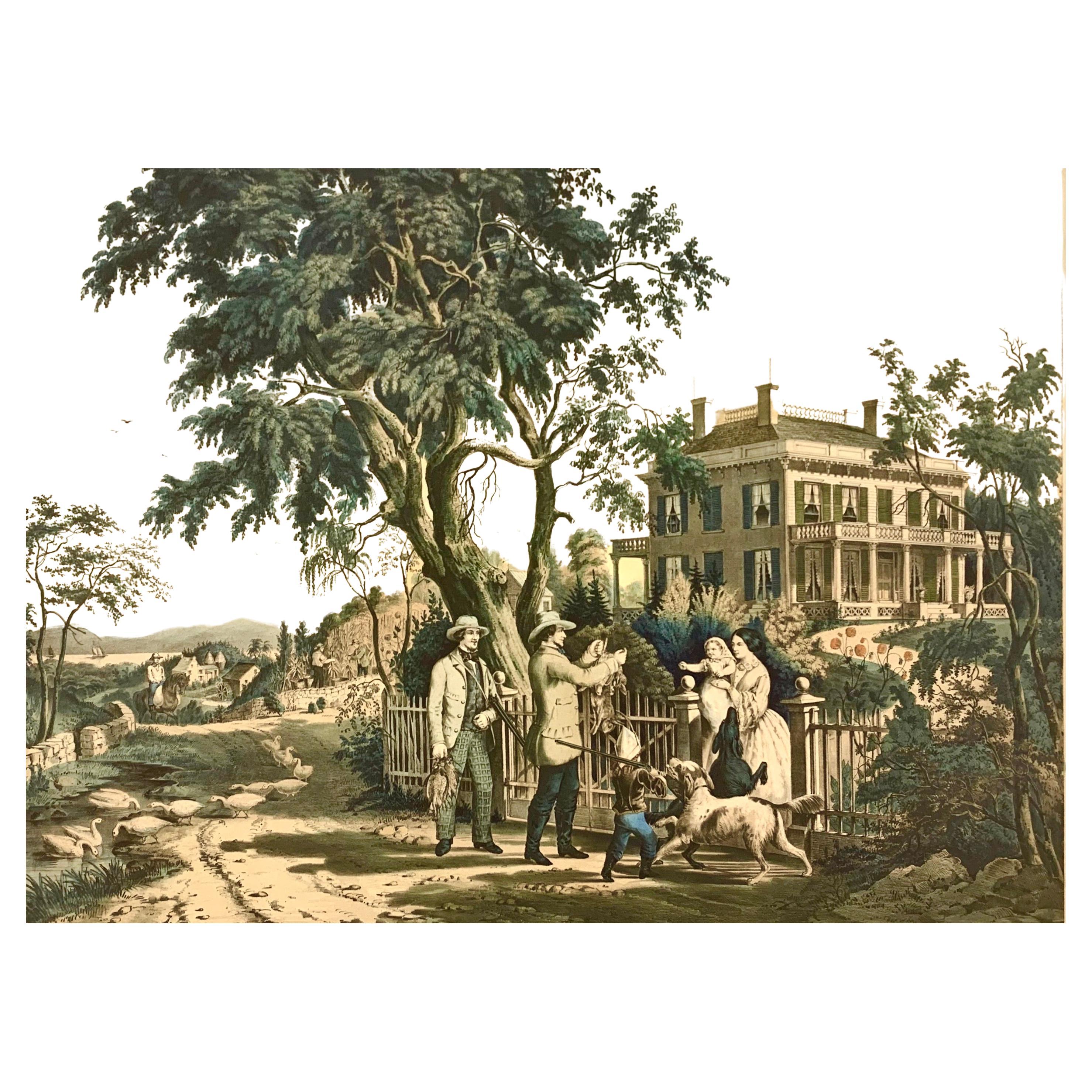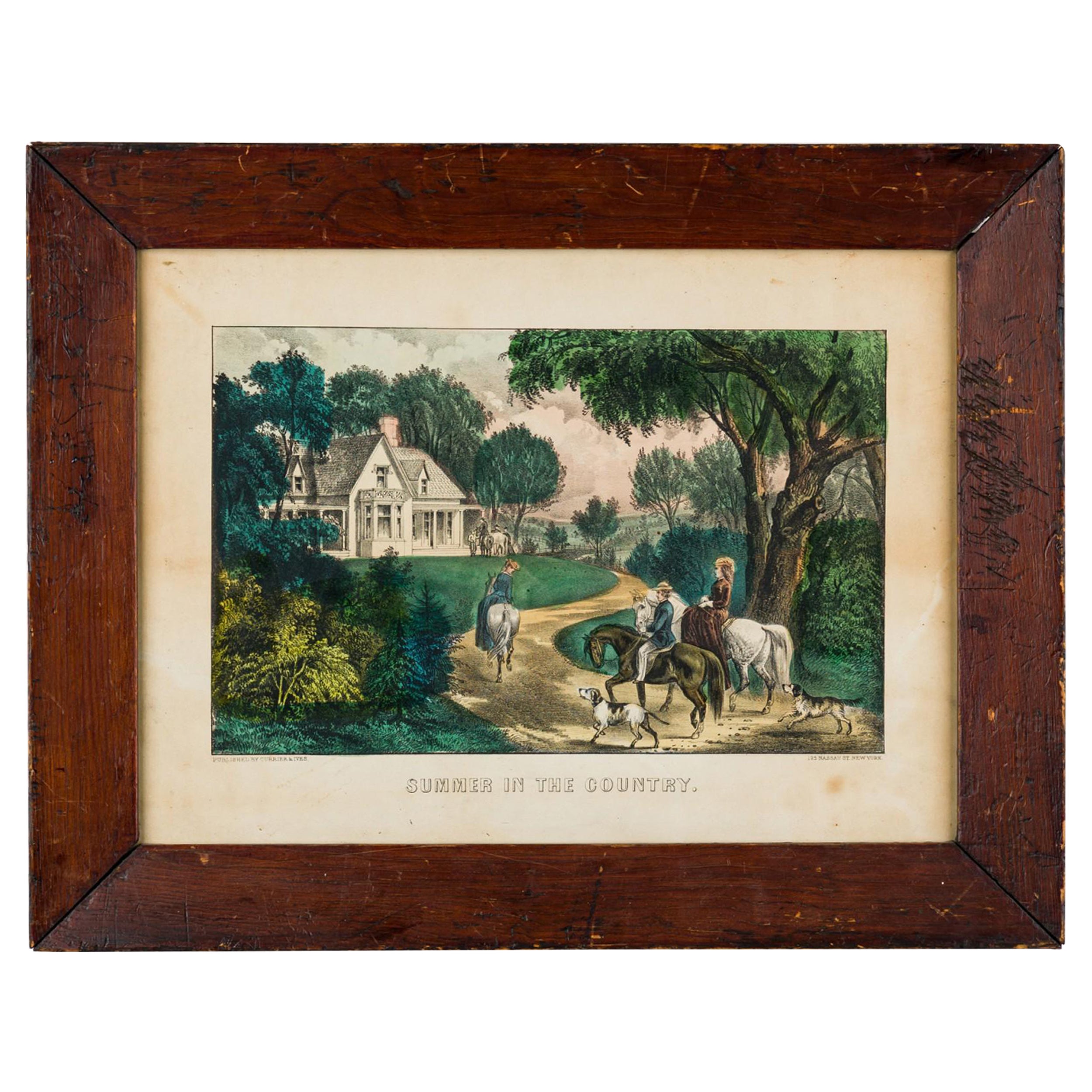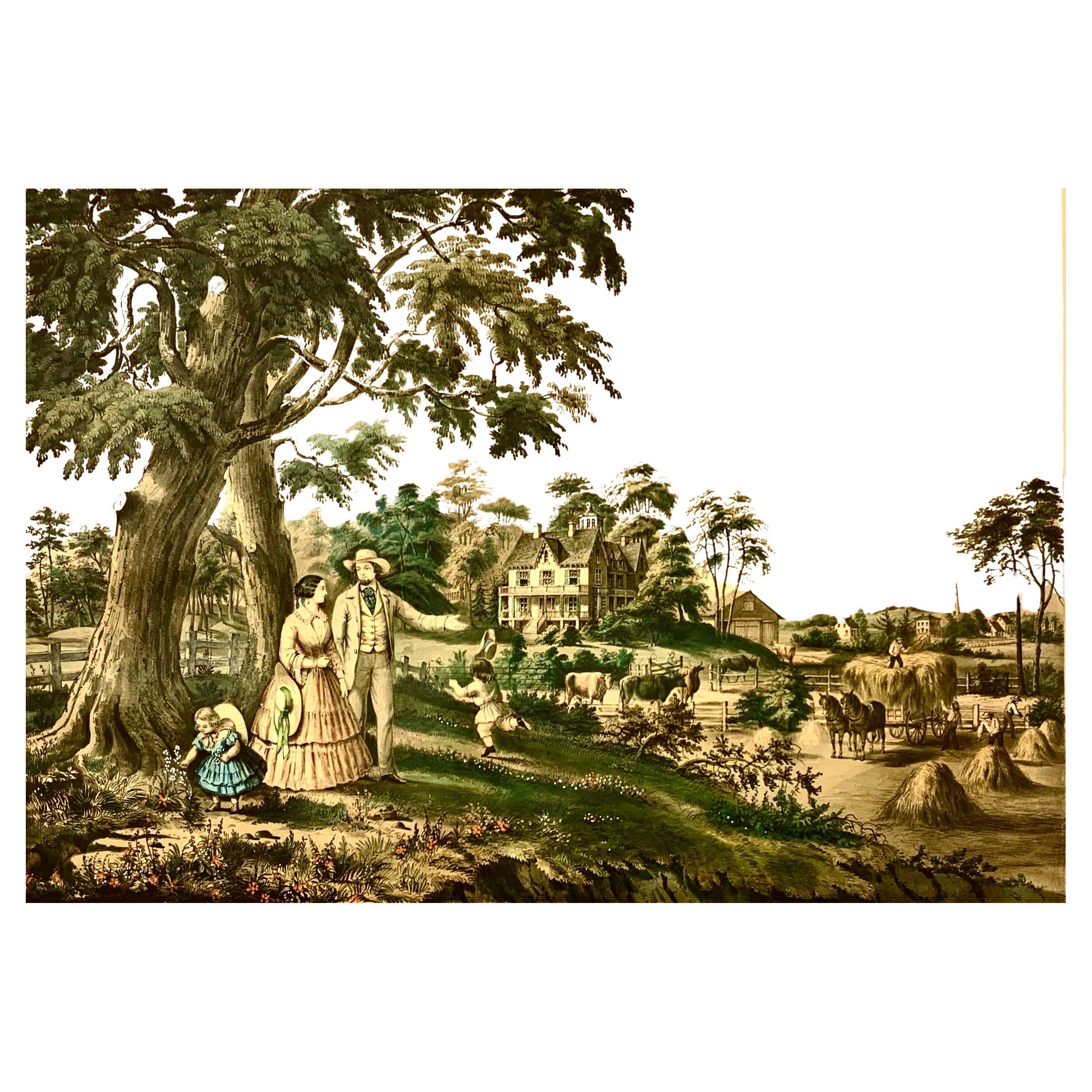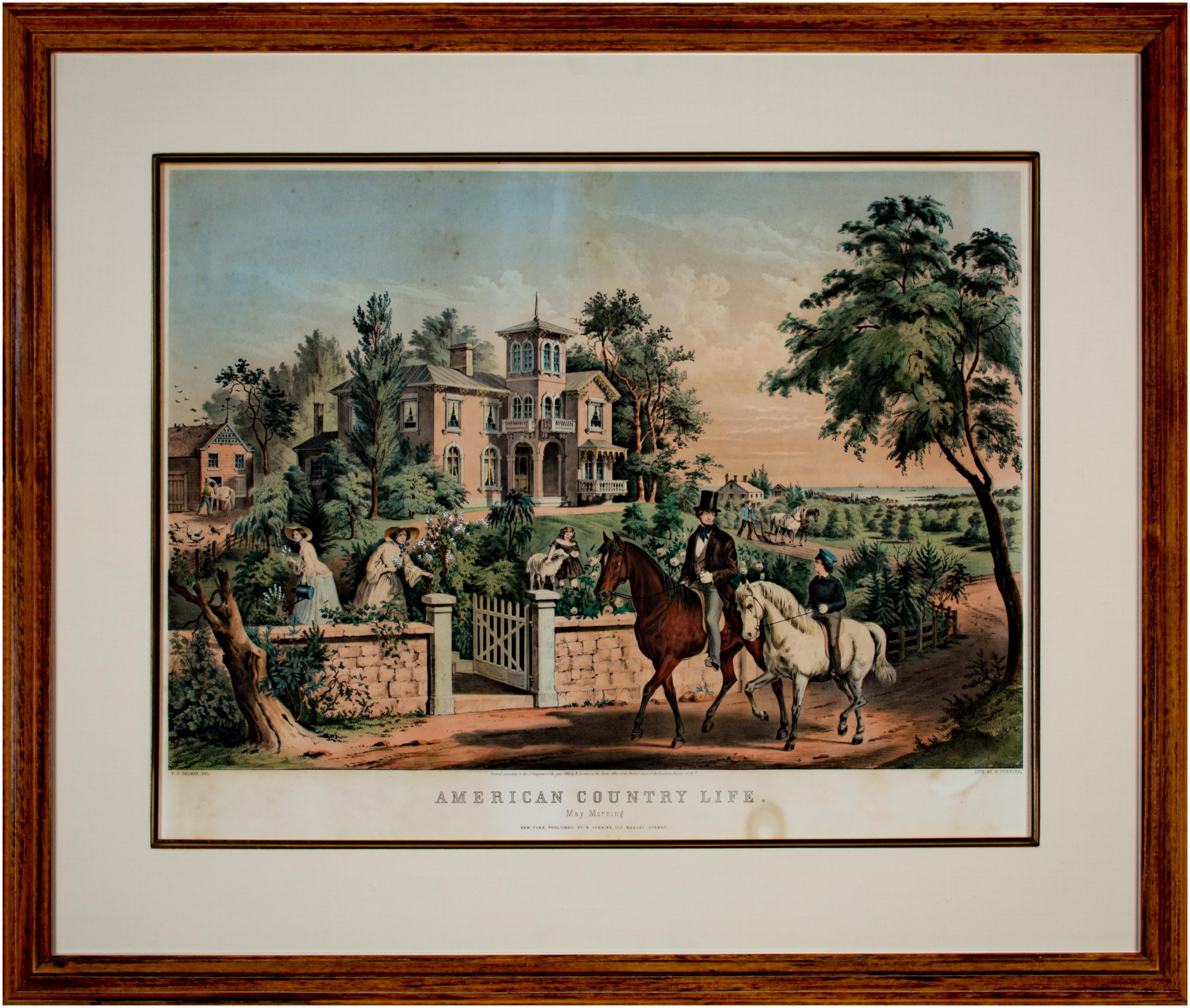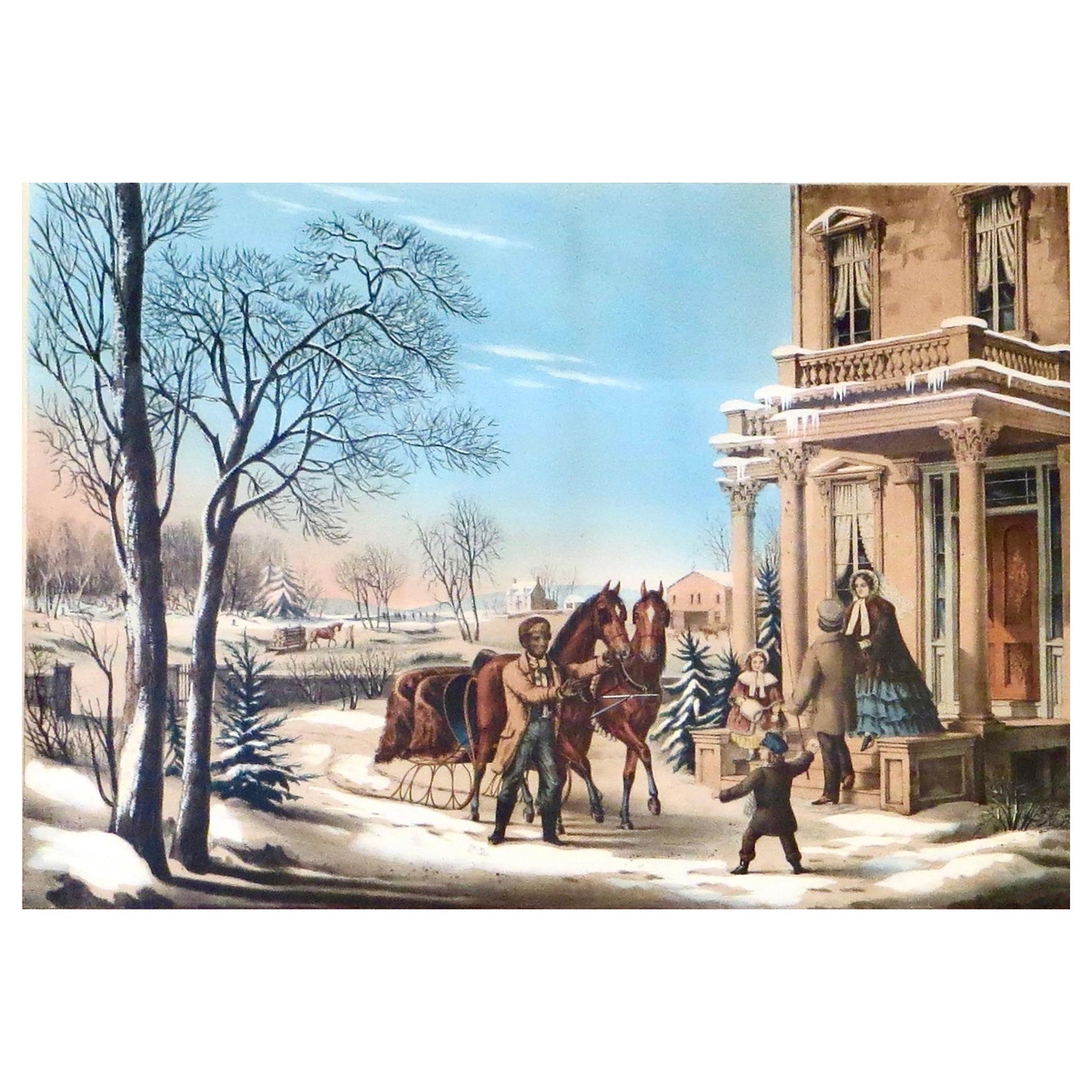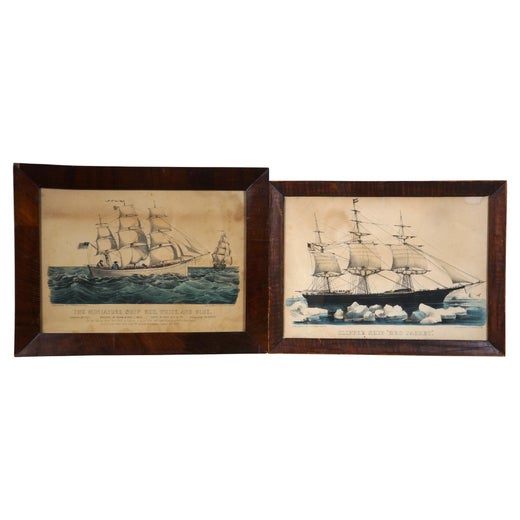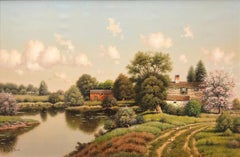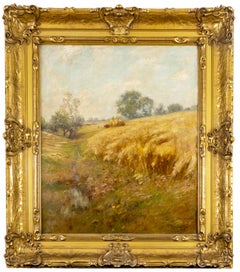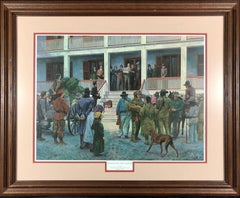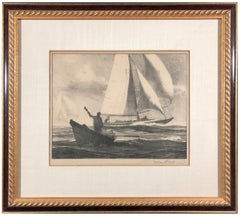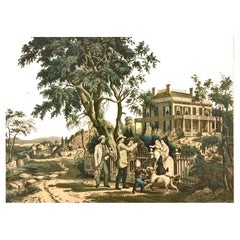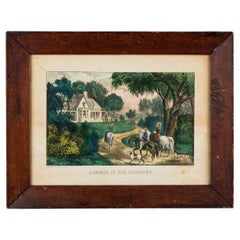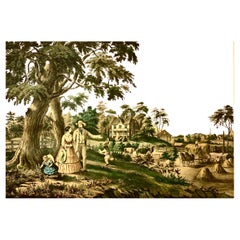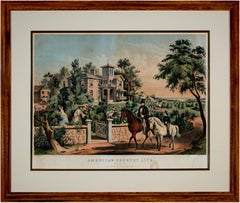Items Similar to Good Times on the Old Plantation
Want more images or videos?
Request additional images or videos from the seller
1 of 6
Currier & IvesGood Times on the Old Plantation1872
1872
$1,850
£1,425.02
€1,627.21
CA$2,639.44
A$2,888.41
CHF 1,514.84
MX$34,522.67
NOK 19,117.20
SEK 17,834.04
DKK 12,152.28
About the Item
Currier & Ives (Publishers)
"Good times on the Old Plantation" 1872
Handcolored Lithograph
Size Height 10 in.; Width 13.9 in.
Framed Size: approx 16 x 19.5
- Creator:Currier & Ives (1834 - 1907, American)
- Creation Year:1872
- Dimensions:Height: 16 in (40.64 cm)Width: 19.5 in (49.53 cm)Depth: 0.5 in (1.27 cm)
- Medium:
- Movement & Style:
- Period:
- Condition:
- Gallery Location:Missouri, MO
- Reference Number:1stDibs: LU74734418821
Currier & Ives
Currier and Ives was a prominent American printmaking establishment headquartered in New York operating from 1835 to 1907. Nathaniel Currier (1813-1888) started his business on his own, but later merged with James Merritt Ives (1824-1895), becoming "Currier and Ives" in 1857. They produced and sold hand-colored lithographs which could be produced relatively quickly and cheaply. They called themselves "the Grand Central Depot for Cheap and Popular Prints". The company published around 7,500 lithographs in its 72 years in business.
About the Seller
5.0
Vetted Professional Seller
Every seller passes strict standards for authenticity and reliability
Established in 1970
1stDibs seller since 2017
156 sales on 1stDibs
Typical response time: Several days
- ShippingRetrieving quote...Shipping from: Missouri, MO
- Return Policy
More From This Seller
View AllSpringtime at the Farm
Located in Missouri, MO
George W. Drew (1875-1968)
"Springtime at the Farm"
Oil on Canvas
24 x 36 inches (site)
31.5 x 43.25 (framed)
George W. Drew was born 21 December 1875 in Massachusetts. He was a member of the Independent Artists Association. He exhibited at the National Academy of Design and they have him recorded as living at 745 Columbus Ave., N.Y. in the year 1898. He also exhibited at the Allied Artists of America, which was established in 1914, Salons of America, N.Y. State Fair, Newark State Fair, Newark Museum and New York Museum of Science & Industry.
Although there is little known about the personal life of George W. Drew, his paintings appear on the art market quite often. It is obvious that his work has always been well received because of the numerous exhibitions he has participated in. He is known for his rustic luminous depictions of the Nineteenth Century American Landscape. Like many of the Hudson River Painters...
Category
Early 20th Century American Impressionist Landscape Paintings
Materials
Canvas, Oil
Price Upon Request
A Day in June, Scene Eastchest, New York
By Edward B. Gay
Located in Missouri, MO
"A Day in June, Scene Eastchest, New York" 1898
Edward Gay (Irish, American, 1837-1928)
Oil on Canvas
Complimented by original frame in great condition
Signed and Dated Lower Right
T...
Category
1890s Hudson River School Landscape Paintings
Materials
Canvas, Oil
Announcing the Charter for the First Bank in the Missouri Territory 1813
By Mort Künstler
Located in Missouri, MO
Publisher's Print
Image Size: approx 24 x 30 inches
Framed Size: approx 31 x 37 inches
Known for his Civil War genre paintings, Mort Kunstler studied art at Brooklyn College, U.C.L.A., and Pratt Institute in Brooklyn. He became a successful illustrator in New York and received assignments including numerous book and magazine publishers.
He was affiliated with the National Geographic Magazine, and through their assignments of historical subject matter, learned the value of accuracy by working with historians. He also did illustrations for The Saturday Evening Post, Newsweek, and Argosy.
In the early 1970s, his work began attracting the attention of collectors. His first paintings were primarily Western subject matter, and from 1977 he has had nine one-man shows at the Hammer Gallery in New York City.
In 1982, he had a commission from CBS to do a painting for the television mini series "Blue and Gray," and this activity directed his attention to the Civil War. A painting, The High Water Mark, was very correct in its details and was unveiled on July 2, 1988 at the Gettysburg National Military Park in celebration of the anniversary of the battle.
He has also completed an official U.S. postal stamp commemorating the Buffalo Soldiers...
Category
20th Century Realist Figurative Prints
Materials
Color
Work and Play
By Gordon Grant
Located in Missouri, MO
Gordan Hope Grant (1875-1962)
"Work and Play"
Lithograph
Signed in Pencil Lower Right
Image Size: 9 x 11.5 inches
Framed Size: approx 18 x 20.5 inches
Born in San Francisco, Gordon Grant is known for his etchings and paintings of marine subjects. He also painted portraits, streets, harbors, beaches and marines, and was an illustrator, whose work included pulp fiction* for Popular Detective magazine in the 1930s. Skilled with watercolor, Grant was honored many times by the American Watercolor Society*. Memberships included the Society of Illustrators*, Salmagundi Club*, Allied Artists of America*, New York Society of Painters, and American Federation of Artists*.
At age 13, he was sent to Scotland for schooling, and the four-month sail around Cape Horn remained a permanent influence on his career. He studied art in Heatherly and at the Lambeth School of Art* in London, and then in 1895, he became a staff artist for the San Francisco Examiner. The next year, he took the same type of job for the New York World and covered the Boer War for Harper's Weekly. He also worked for Puck magazine...
Category
Mid-20th Century American Realist Figurative Prints
Materials
Lithograph
Price Upon Request
The Jolly Flat Boat Men
By George Caleb Bingham
Located in Missouri, MO
The Jolly Flat Boat Men, 1847
After George Caleb Bingham (American, 1811-1879)
Engraved by Thomas Doney (French, active New York 1844-1849)
Engraving with Hand-Coloring
Published by The American Art-Union, New York (1838-1851)
Printed by Powell and Co.
18 x 24 inches
32 x 38 inches with frame
In 1847, the American Art-Union purchased Bingham’s painting "The Jolly Flat Boat Men" (1846; National Gallery of Art) directly from the artist. The subscription-based organization, founded in 1838 as the Apollo Association, boasted nearly ten-thousand members at this date. For an annual fee of five dollars, each received a large reproductive engraving and was entered in a lottery to win original artworks exhibited at the Art-Union’s Free Gallery. Aimed at educating the public about contemporary American art, the organization developed an impressive distribution network that reached members in every state. The broad circulation of the Art-Union's print helped to establish Bingham's reputation and made his river scene famous.
Born in Augusta County, Virginia in the Shenandoah River Valley, George Caleb Bingham became known for classically rendered western genre, especially Missouri and Mississippi River scenes of boatmen bringing cargo to the American West and politicians seeking to influence frontier life. One of his most famous river genre paintings was The Jolly Flatboatmen completed in several versions in 1846. This first version of this painting is in the Manoogian Collection at the National Gallery of Art. Fame resulted for this work when it was exhibited in New York at the American Art Union whose organizers made an engraving of 10,000 copies and distributed it to all of their members. Paintings such as Country Politician (1849) and County Election (1852) and Stump Speaking (1854) reflected Bingham's political interests.
In 1819, as an eight-year old, he moved to Boon's Lick, Missouri with his parents and grandfather who had been farmers and inn keepers in the Shenandoah Valley near Rockingham, Virginia. Reportedly as a child there, he took every opportunity to escape supervision to travel the River and watch the marine activity.
His father died in 1827, when his son was sixteen years old. His mother had encouraged his art talent, but art lessons were not easily obtainable. In order to earn money, he apprenticed to a cabinet maker but determined to become an artist. By 1835, he had a modest reputation as a frontier painter and successfully charged twenty dollars per portrait in St. Louis. "His portraits had become standard decorations in prosperous Missouri homes." (Samuels 46). In 1836, he moved to Natchez, Mississippi and there had the same kind of career, only was able to charge forty dollars per portrait.
He remained largely self taught until 1837, when he, age 26 and using the proceeds from his portraiture, studied several months at the Pennsylvania Academy of the Fine Arts. He later said that he learned much of his atmospheric style and classically balanced composition by copying paintings in collections in St. Louis and Philadelphia and that among his most admired painters were Thomas Cole, John Vanderlyn, and William Sidney Mount. Between 1856 and 1859, Bingham traveled back and forth to Dusseldorf, Germany, where he studied the work of genre painters. Some critics think these influences were negative on his work because during that time period, he abandoned his luminist style that had brought him so much public affirmation.
Bingham credited Chester Harding (1792-1866) as being the earliest and one of the most lasting influences on his work. Harding,a leading portraitists when Bingham was a young man, had a studio in Franklin, near Bingham's home town. In 1822, when Bingham was ten years old, he watched Harding finish a portrait of Daniel Boone. Bingham recalled that watching Harding with the Boone portrait was a lasting inspiration and that it was the first time he had ever seen a painting in progress. Harding suggested to Bingham that he begin doing portraiture by finding subjects in the river men, which, of course, opened the subject matter that established fame and financial success for Bingham. Harding also encouraged Bingham to copy with paint engravings. He later painted two portraits of Boone but, contrary to the assertions of some scholars, he did not do Boone portraits in the company of Harding.
Bingham's portraits of Boone are not located, but one of them, a wood signboard for a hotel in Boonville circa 1828 to 1830, showed a likeness of Boone in buckskin dress...
Category
1840s Hudson River School Figurative Prints
Materials
Engraving
Boston
By John William Hill
Located in Missouri, MO
John William Hill (1812-1879)
"Boston" 1857
Hand-Colored Engraving
Site Size: 29 x 41 inches
Framed Size: 39 x 52 inches
Born in London, England, John William Hill came to America with his family at age 7. His father, John Hill, was a well-known landscape painter, engraver, and aquatintist. John William had a career of two phases, a city topographer-engraver and then, the leading pre-Rafaelite school painter in this country. Employed by the New York Geological Survey and then by Smith Brothers...
Category
1850s Pre-Raphaelite Landscape Prints
Materials
Engraving, Aquatint
Price Upon Request
You May Also Like
Nathan Currier Lithograph "October Afternoon" American Country Life Series C1855
By Currier & Ives
Located in Incline Village, NV
"October Afternoon" Maintains the appropriate markings along with "New York, Published by N. Currier 152 Nassau Street.
(The firm was located here in lower Manhattan from 1837-1872)
The lithograph illustrates two men and their dog with young son (hunting rifle over shoulder) in tow, returning from the rabbit hunt with their catch being presented to the lady of the house with baby in arms. The gated mansion is in the background while geese float upon the fertile pond in the background.
In addition to the Amon Carter Museum in Dallas, an example of "Pleasures of Winter" is in:
The Metropolitan Museum of Art (Bequest of Adele S. Colgate, 1962)
Museum of Fine Arts Boston (Donated by Lee M. Friedman)
The Library of Congress
The Yale University Art Gallery (Gift of Mabel Brady Garvan Collection)
Dimensions: actual= 16 1/2" h x 23 13/16" w
matte= 19 1/2" h x 25 1/4" w
folio= 21 1/4" h x 27 3/4" w
with frame= 26 1/4" h x 32 1/4" w
frame= 1 1/4" burl bird's eye maple
It is in very good all original condition; and housed and professionally mounted in a fine quality and attractive bird's eye maple wooden frame with preservation backing and frontal protective glass (important when dealing with 170 year old lithographs); it is the rare and desirable Currier large folio sheet example in fine original color. There is some slight foxing to the cream border and minor fading (see images),
The larger folios are more rare because they appealed to the wealthier sector of the population and were more expensive, thus fewer were made, albeit, knowing their more discerning customer base, there was more attention given to detail; hand coloring, and quality for example. This example has been framed and housed in museum quality conservation backing for over 80 years. I have had it professionally taken apart and I inspected the folio visually, and examined it with a black light and loop; as a result, I guarantee and can attest to the accuracy of my description of the lithograph. I then had the folio professionally remounted in it's original frame with an upgraded preservation backing (see images of original folios out of frame and for confirmation of inspection). This lithograph has no tears, no touch up paint, and no glued or taped repairs.
This is one of the four iconic and highly desirable set of lithographs made by Nathaniel Currier (1813-1888) dated 1855 from the American Country Life series. They are named;
Spring "May Morning";
Summer "Summer Evening";
Fall ""October Afternoon"; and
Winter "Pleasures of Winter".
The lithograph was produced from the painting of well known artist Frances (Fanny) Flora (Bond Palmer (1812-1876). She painted typical American scenes of daily American life that were used by Currier for years to come. She was an accomplished artist by the time she migrated to the United States from England, and Currier commissioned her to do the country scenes for this series. Each of the original images are toned lithographs with applied hand painted watercolor.
The lithograph reflects an affluent life style, showcasing grandiose homes and glamorizing the rural way of living as urban areas became more densely populated with the tidal wave and arrival of immigrants. Nathaniel Currier began his lithograph business in 1835 with hand colored images portraying outdoor panoramic, historical, pastoral, and landmark scenes and events, with which the middle class and the wealthy sought to decorate their houses. James Ives (1824-1895) was his accountant) and would join him later in 1857 to help run the business.
The hand painted lithograph is embellished with script text in the bottom margin of the folio "Entered according to art of congress in the year 1855 by N. Currier in the clerk's office of the southern district of N.Y."
"F.F Palmer...
Category
Antique 1850s Victorian Prints
Materials
Paper
Currier & Ives Lithograph of Summer in the Country
By Currier & Ives
Located in Queens, NY
American Victorian wood framed lithograph of riders on path titled Summer in the Country (Currier & Ives)
Category
Antique Late 19th Century American Victorian Paintings
Materials
Wood
Nathaniel Currier Lithograph Summer's Evening American Country Life Series C1855
By Currier & Ives
Located in Incline Village, NV
"Summer's Evening" folio has the appropriate Currier and Ives' markings along with "New York, Published by N. Currier 152 Nassau Street.
(The firm was located here in lower Manhattan from 1837-1872)
The lithograph depicts a young well dressed and well to do family overlooking their property as workers tend to the farmland and harvest hay. Note the haystacks and a horse drawn hay wagon. The large and well built farm house stands proudly over the scene with the village in the background.
In addition to the Amon Carter Museum in Dallas, an example of "Summer's Evening" is in The Springfield Museum (Massachusetts) Gift of Lenore and Sydney Alpert).
Dimensions: actual= 16 1/2" h x 23 13/16" w
matte= 19 1/2" h x 25 1/4" w
folio= 19 7/8" h x 26" w
with frame= 26 1/4" h x 32 1/4" w
frame= 1 1/4" burl bird's eye maple
It is in very good all original condition; and housed and professionally mounted in a fine quality and attractive bird's eye maple wooden frame with preservation backing and frontal protective glass (important when dealing with 170 year old lithographs); it is the rare and desirable Currier large folio sheet example in fine original color. There is some toning and foxing (see images).
The larger folios are more rare because they appealed to the wealthier sector of the population and were more expensive, thus fewer were made, albeit, knowing their more discerning customer base, there was more attention given to detail; hand coloring, and quality for example. This example has been framed and housed in museum quality conservation backing for over 80 years. I have had it professionally taken apart and I inspected the folio visually, and examined it with a black light and loop; as a result, I guarantee and can attest to the accuracy of my description of the lithograph. I then had the folio professionally remounted in it's original frame with an upgraded preservation backing (see images of original folios out of frame and for confirmation of inspection). This lithograph has no tears, no touch up paint, and no glued or taped repairs.
This is one of the four iconic and highly desirable set of lithographs made by Nathaniel Currier (1813-1888) dated 1855 from the American Country Life series. They are named;
Spring "May Morning";
Summer "Summer Evening";
Fall ""October Afternoon"; and
Winter "Pleasures of Winter".
The lithograph was produced from the painting of well known artist Frances (Fanny) Flora (Bond Palmer (1812-1876). She painted typical American scenes of daily American life that were used by Currier for years to come. She was an accomplished artist by the time she migrated to the United States from England, and Currier commissioned her to do the country scenes for this series. Each of the original images are toned lithographs with applied hand painted watercolor.
The lithograph reflects an affluent life style, showcasing grandiose homes and glamorizing the rural way of living as urban areas became more densely populated with the tidal wave and arrival of immigrants. Nathaniel Currier began his lithograph business in 1835 with hand colored images portraying outdoor panoramic, historical, pastoral, and landmark scenes and events, with which the middle class and the wealthy sought to decorate their houses. James Ives (1824-1895) was his accountant) and would join him later in 1857 to help run the business.
The hand painted lithograph is embellished with script text in the bottom margin of the folio "Entered according to art of congress in the year 1855 by N. Currier in the clerk's office of the southern district of N.Y."
"F.F Palmer...
Category
Antique 1850s American Victorian Prints
Materials
Paper
19th century color lithograph landscape figures horseback house scene trees sky
By Nathaniel Currier
Located in Milwaukee, WI
The present print is one of several examples produced for Nathaniel Currier by his longtime collaborator Frances F. "Fanny" Palmer. Harry T. Peters wrote of her: "There is no more interesting and appealing character among the group of artists who worked for Currier & Ives than Fanny Palmer. In an age when women, well-bred women in particular, did not generally work for a living Fanny Palmer for years did exacting, full-time work in order to support a large and dependent family ... Her work ... had great charm, homeliness, and a conscientious attention to detail."
One of a series of four prints showing American country life in different seasons, the image presents the viewer with a picturesque view of a successful American farm. In the foreground, a gentleman rides a horse with a young boy before a respectable Italianate country house. Two women and a young girl pick flowers in the garden and several farm workers attend to their duties. Beyond are other homes and a city on the coast.
16.63 x 23.75 inches, artwork
28.13 x 33.38 inches, frame
Entitled bottom center "American Country Life - May Morning"
Signed in the stone, lower left "F.F. Palmer, Del."
Signed in the stone, lower right "Lith. by N. Currier"
Copyrighted lower center "Entered according to Act of Congress in the year 1855 by N. Currier in the Clerk's office of the Southern District of N.Y."
Inscribed bottom center "New York, Published by N. Currier 152 Nassau Street"
Framed to conservation standards using silk-lined 100 percent rag matting and Museum Glass with a gold gilded liner, all housed in a stained wood moulding.
Nathaniel Currier was a tall introspective man with a melancholy nature. He could captivate people with his piercing stare or charm them with his sparkling blue eyes. Nathaniel was born in Roxbury, Massachusetts on March 27th, 1813, the second of four children. His parents, Nathaniel and Hannah Currier, were distant cousins who lived a humble yet spartan life. When Nathaniel was eight years old, tragedy struck. Nathaniel’s father unexpectedly passed away leaving Nathaniel and his eleven-year-old brother Lorenzo to provide for the family. In addition to their mother, Nathaniel and Lorenzo had to care for six-year-old sister Elizabeth and two-year-old brother Charles. Nathaniel worked a series of odd jobs to support the family, and at fifteen, he started what would become a life-long career when he apprenticed in the Boston lithography shop of William and John Pendleton.
A Bavarian gentleman named Alois Senefelder invented lithography just 30 years prior to young Nat Currier’s apprenticeship. While under the employ of the brothers Pendleton, Nat was taught the art of lithography by the firm’s chief printer, a French national named Dubois, who brought the lithography trade to America.
Lithography involves grinding a piece of limestone flat and smooth then drawing in mirror image on the stone with a special grease pencil. After the image is completed, the stone is etched with a solution of aqua fortis leaving the greased areas in slight relief. Water is then used to wet the stone and greased-ink is rolled onto the raised areas. Since grease and water do not mix, the greased-ink is repelled by the moisture on the stone and clings to the original grease pencil lines. The stone is then placed in a press and used as a printing block to impart black on white images to paper.
In 1833, now twenty-years old and an accomplished lithographer, Nat Currier left Boston and moved to Philadelphia to do contract work for M.E.D. Brown, a noted engraver and printer. With the promise of good money, Currier hired on to help Brown prepare lithographic stones of scientific images for the American Journal of Sciences and Arts. When Nat completed the contract work in 1834, he traveled to New York City to work once again for his mentor John Pendleton, who was now operating his own shop located at 137 Broadway. Soon after the reunion, Pendleton expressed an interest in returning to Boston and offered to sell his print shop to Currier. Young Nat did not have the financial resources to buy the shop, but being the resourceful type he found another local printer by the name of Stodart. Together they bought Pendleton’s business.
The firm ‘Currier & Stodart’ specialized in "job" printing. They produced many different types of printed items, most notably music manuscripts for local publishers. By 1835, Stodart was frustrated that the business was not making enough money and he ended the partnership, taking his investment with him. With little more than some lithographic stones, and a talent for his trade, twenty-two year old Nat Currier set up shop in a temporary office at 1 Wall Street in New York City. He named his new enterprise ‘N. Currier, Lithographer’
Nathaniel continued as a job printer and duplicated everything from music sheets to architectural plans. He experimented with portraits, disaster scenes and memorial prints, and any thing that he could sell to the public from tables in front of his shop. During 1835 he produced a disaster print Ruins of the Planter's Hotel, New Orleans, which fell at two O’clock on the Morning of the 15th of May 1835, burying 50 persons, 40 of whom Escaped with their Lives. The public had a thirst for newsworthy events, and newspapers of the day did not include pictures. By producing this print, Nat gave the public a new way to “see” the news. The print sold reasonably well, an important fact that was not lost on Currier.
Nat met and married Eliza Farnsworth in 1840. He also produced a print that same year titled Awful Conflagration of the Steamboat Lexington in Long Island Sound on Monday Evening, January 18, 1840, by which melancholy occurrence over One Hundred Persons Perished. This print sold out very quickly, and Currier was approached by an enterprising publication who contracted him to print a single sheet addition of their paper, the New York Sun. This single page paper is presumed to be the first illustrated newspaper ever published.
The success of the Lexington print launched his career nationally and put him in a position to finally lift his family up. In 1841, Nat and Eliza had their first child, a son they named Edward West Currier. That same year Nat hired his twenty-one year old brother Charles and taught him the lithography trade, he also hired his artistically inclined brother Lorenzo to travel out west and make sketches of the new frontier as material for future prints. Charles worked for the firm on and off over the years, and invented a new type of lithographic crayon which he patented and named the Crayola. Lorenzo continued selling sketches to Nat for the next few years.
In 1843, Nat and Eliza had a daughter, Eliza West Currier, but tragedy struck in early 1847 when their young daughter died from a prolonged illness. Nat and Eliza were grief stricken, and Eliza, driven by despair, gave up on life and passed away just four months after her daughter’s death.
The subject of Nat Currier’s artwork changed following the death of his wife and daughter, and he produced many memorial prints and sentimental prints during the late 1840s. The memorial prints generally depicted grief stricken families posed by gravestones (the stones were left blank so the purchasers could fill in the names of the dearly departed). The sentimental prints usually depicted idealized portraits of women and children, titled with popular Christian names of the day.
Late in 1847, Nat Currier married Lura Ormsbee, a friend of the family. Lura was a self-sufficient woman, and she immediately set out to help Nat raise six-year-old Edward and get their house in order. In 1849, Lura delivered a son, Walter Black Currier, but fate dealt them a blow when young Walter died one year later. While Nat and Lura were grieving the loss of their new son, word came from San Francisco that Nat’s brother Lorenzo had also passed away from a brief illness. Nat sank deeper into his natural quiet melancholy. Friends stopped by to console the couple, and Lura began to set an extra place at their table for these unexpected guests. She continued this tradition throughout their lives.
In 1852, Charles introduced a friend, James Merritt Ives, to Nat and suggested he hire him as a bookkeeper. Jim Ives was a native New Yorker born in 1824 and raised on the grounds of Bellevue Hospital where his father was employed as superintendent. Jim was a self-trained artist and professional bookkeeper. He was also a plump and jovial man, presenting the exact opposite image of his new boss.
Jim Ives met Charles Currier through Caroline Clark, the object of Jim’s affection. Caroline’s sister Elizabeth was married to Charles, and Caroline was a close friend of the Currier family. Jim eventually proposed marriage to Caroline and solicited an introduction to Nat Currier, through Charles, in hopes of securing a more stable income to support his future wife.
Ives quickly set out to improve and modernize his new employer’s bookkeeping methods. He reorganized the firm’s sizable inventory, and used his artistic skills to streamline the firm’s production methods. By 1857, Nathaniel had become so dependent on Jims’ skills and initiative that he offered him a full partnership in the firm and appointed him general manager. The two men chose the name ‘Currier & Ives’ for the new partnership, and became close friends.
Currier & Ives produced their prints in a building at 33 Spruce Street where they occupied the third, fourth and fifth floors. The third floor was devoted to the hand operated printing presses that were built by Nat's cousin, Cyrus Currier, at his shop Cyrus Currier & Sons in Newark, NJ. The fourth floor found the artists, lithographers and the stone grinders at work. The fifth floor housed the coloring department, and was one of the earliest production lines in the country. The colorists were generally immigrant girls, mostly German, who came to America with some formal artistic training. Each colorist was responsible for adding a single color to a print. As a colorist finished applying their color, the print was passed down the line to the next colorist to add their color. The colorists worked from a master print displayed above their table, which showed where the proper colors were to be placed. At the end of the table was a touch up artist who checked the prints for quality, touching-in areas that may have been missed as it passed down the line. During the Civil War, demand for prints became so great that coloring stencils were developed to speed up production.
Although most Currier & Ives prints were colored in house, some were sent out to contract artists. The rate Currier & Ives paid these artists for coloring work was one dollar per one hundred small folios (a penny a print) and one dollar per one dozen large folios. Currier & Ives also offered uncolored prints to dealers, with instructions (included on the price list) on how to 'prepare the prints for coloring.' In addition, schools could order uncolored prints from the firm’s catalogue to use in their painting classes.
Nathaniel Currier and James Merritt Ives attracted a wide circle of friends during their years in business. Some of their more famous acquaintances included Horace Greeley, Phineas T. Barnum, and the outspoken abolitionists Rev. Henry Ward, and John Greenleaf Whittier (the latter being a cousin of Mr. Currier).
Nat Currier and Jim Ives described their business as "Publishers of Cheap and Popular Pictures" and produced many categories of prints. These included Disaster Scenes, Sentimental Images, Sports, Humor, Hunting Scenes, Politics, Religion, City and Rural Scenes, Trains, Ships, Fire Fighters, Famous Race Horses, Historical Portraits, and just about any other topic that satisfied the general public's taste. In all, the firm produced in excess of 7500 different titles, totaling over one million prints produced from 1835 to 1907.
Nat Currier retired in 1880, and signed over his share of the firm to his son Edward. Nat died eight years later at his summer home 'Lion’s Gate' in Amesbury, Massachusetts. Jim Ives remained active in the firm until his death in 1895, when his share of the firm passed to his eldest son, Chauncey.
In 1902, faced will failing health from the ravages of Tuberculosis, Edward Currier sold his share of the firm to Chauncey Ives...
Category
Mid-19th Century Romantic Figurative Prints
Materials
Watercolor, Lithograph
N. Currier Lithograph" Pleasures of Winter" American Country Life Series C.1855
By Currier & Ives
Located in Incline Village, NV
"Pleasures of Winter" Maintains the appropriate markings along with "New York, Published by N. Currier 152 Nassau Street.
(The firm was located here in lower Manhattan from 1837-1872)
The lithograph portrays a woman leaving her stately home with her two children, being escorted by two drivers to ride in a double seated horse drawn sleigh. In the background is a snowy field with other houses and a loaded horse drawn timber sleigh.
In addition to the Amon Carter Museum in Dallas, an example of "Pleasures of Winter" is in:
The Library of Congress
The Springfield Museum (Massachusetts) Gift of Lenore and Sydney Alpert)
Metropolitan Museum of Art (Gift of Colgate 1962)
Museum of Fine Arts Boston (Donated by Lee M. Friedman)
Dimensions: actual= 16 1/2" h x 23 13/16" w
matte= 19 1/2" h x 25 1/4" w
folio= 21 9/16" h x 27 1/2" w
with frame= 26 1/4" h x 32 1/4" w
frame= 1 1/4" burl bird's eye maple
It is in very good all original condition; and housed and professionally mounted in a fine quality and attractive bird's eye maple wooden frame with preservation backing and frontal protective glass (important when dealing with 170 year old lithographs); it is the rare and desirable Currier large folio sheet example in fine original color. There is minor foxing and a tideline upper center (see images).
The larger folios are more rare because they appealed to the wealthier sector of the population and were more expensive, thus fewer were made, albeit, knowing their more discerning customer base, there was more attention given to detail; hand coloring, and quality for example. This example has been framed and housed in museum quality conservation backing for over 80 years. I have had it professionally taken apart and I inspected the folio visually, and examined it with a black light and loop; as a result, I guarantee and can attest to the accuracy of my description of the lithograph. I then had the folio professionally remounted in it's original frame with an upgraded preservation backing (see images of original folios out of frame and for confirmation of inspection). This lithograph has no tears, no touch up paint, and no glued or taped repairs.
This is one of the four iconic and highly desirable set of lithographs made by Nathaniel Currier (1813-1888) dated 1855 from the American Country Life series. They are named;
Spring "May Morning";
Summer "Summer Evening";
Fall ""October Afternoon"; and
Winter "Pleasures of Winter".
The lithograph was produced from the painting of well known artist Frances (Fanny) Flora (Bond Palmer (1812-1876). She painted typical American scenes of daily American life that were used by Currier for years to come. She was an accomplished artist by the time she migrated to the United States from England, and Currier commissioned her to do the country scenes for this series. Each of the original images are toned lithographs with applied hand painted watercolor.
The lithograph reflects an affluent life style, showcasing grandiose homes and glamorizing the rural way of living as urban areas became more densely populated with the tidal wave and arrival of immigrants. Nathaniel Currier began his lithograph business in 1835 with hand colored images portraying outdoor panoramic, historical, pastoral, and landmark scenes and events, with which the middle class and the wealthy sought to decorate their houses. James Ives (1824-1895) was his accountant) and would join him later in 1857 to help run the business.
The hand painted lithograph is embellished with script text in the bottom margin of the folio "Entered according to art of congress in the year 1855 by N. Currier in the clerk's office of the southern district of N.Y."
"F.F Palmer...
Category
Antique 1850s American Victorian Prints
Materials
Paper
Nathaniel Currier Lithograph "May Morning" American Country Life Series C. 1855
By Currier & Ives
Located in Incline Village, NV
This lithograph portrays a pleasant scene of a man in a top hat atop a handsome dark horse, with a boy riding a white horse (presumably father and son) in front of a country estate, while women gather as they water flowers, and children play with a lamb in the foreground. A man plows a field; while a horse is being groomed near the stable in the background. Afar and to the right is the sea dotted with ships here and there. The folio is mounted on cardboard and set in the matte.
It is in very good all original condition; and housed and professionally mounted in a fine quality and attractive bird's eye maple wooden frame with preservation backing and frontal protective glass (important when dealing with 170 year old lithographs); it is the rare and desirable Currier large folio sheet example in fine original color. There is some toning and slight fading,
The larger folios are more rare because they appealed to the wealthier sector of the population and were more expensive, thus fewer were made, albeit, knowing their more discerning customer base, there was more attention given to detail; hand coloring, and quality for example. This example has been framed and housed in museum quality conservation backing for over 80 years. I have had it professionally taken apart and I inspected the folio visually, and examined it with a black light and loop; as a result, I guarantee and can attest to the accuracy of my description of the lithograph. I then had the folio professionally remounted in their original frame with an upgraded preservation backing (see images of original folios out of frame and for confirmation of inspection). This lithograph has no tears, no touch up paint, and no glued or taped repairs.
This is one of the four iconic and highly desirable set of lithographs made by Nathaniel Currier (1813-1888) dated 1855 from the American Country Life series. They are named;
Spring "May Morning";
Summer "Summer Evening";
Fall ""October Afternoon"; and
Winter "Pleasures of Winter".
The lithograph was produced from the painting of well known artist Frances (Fanny) Flora (Bond Palmer (1812-1876). She painted typical American scenes of daily American life that were used by Currier for years to come. She was an accomplished artist by the time she migrated to the United States from England, and Currier commissioned her to do the country scenes for this series. Each of the original images are toned lithographs with applied hand painted watercolor.
The lithograph reflects an affluent life style, showcasing grandiose homes and glamorizing the rural way of living as urban areas became more densely populated with the tidal wave and arrival of immigrants. Nathaniel Currier began his lithograph business in 1835 with hand colored images portraying outdoor panoramic, historical, pastoral, and landmark scenes and events, with which the middle class and the wealthy sought to decorate their houses. James Ives (1824-1895) was his accountant) and would join him later in 1857 to help run the business.
The hand painted lithograph is embellished with script text in the bottom margin of the folio "Entered according to art of congress in the year 1855 by N. Currier in the clerk's office of the southern district of N.Y."
"F.F Palmer...
Category
Antique 1850s American Victorian Prints
Materials
Paper
More Ways To Browse
Dali Trilogy
Dali Turtle
Dali Venus In Furs
Dali Virgil Last Words
Damien Hirst The Dead
David Dawson
David Hockney Blue Guitar
David Hockney Lemon
David L Abel
David Shrigley Black Cats Everywhere
Degas Ballerina Etchings
Degas Signed Lithograph
Dieu Et Mon Droit
Distorted Face Paintings
Donna Evans
Earl Washington
Eduardo Paolozzi On Sale
Edward Borein Etching
